Ijraset Journal For Research in Applied Science and Engineering Technology
- Home / Ijraset
- On This Page
- Abstract
- Introduction
- Conclusion
- References
- Copyright
Experimental Design and Analysis of MWCNT, Nanoclay and Zinc Oxide Nanofillers on Bi-directional-Chopped Stranded Glass Fibre Reinforced Epoxy matrix on Mechanical Properties using Multi Response Performance Index Approach
Authors: D. Vinay Kumar , B M Rajaprakash, Bupesh Kumar K
DOI Link: https://doi.org/10.22214/ijraset.2024.63546
Certificate: View Certificate
Abstract
The composite manufactured using nanofillers have found to posses better properties in certain application. In the present work, MWCNTs, Nanoclay and ZnO have been used in GFRP. The developed material can be a promising replacement of composites being used for structural applications in the aerospace sector and space technology apart from the automotives to impart light weight, superior bending and tensile strength. The methodology governing the design of experiments plays a vital role in optimization. Experimental design with three Nanofillers as parameters at three levels for optimization of output characteristics with superior properties for structural applications was done using Taguchi’s L9 and L18 orthogonal arrays. Multi Response Performance Index-MRPI technique has been used for determination of maximum optimal level in the present study.Testing for the manufactured composite was conducted to obtain the ultimate tensile strength and flexural bending strength. ANOVA Analysis was performed both for L9 and L18 arrays and respective MRPI’s. The effects of three nanofillers infused GFRP was investigated and their impact on tensile and flexural strength were evaluated.MRPI indicated single maximum optimal level for both the output characteristics. As GFRP play very important role in engineering application for Stealth, mechanical, thermal properties, resistance to fire by limiting oxygen and retarding flame, several human lifes travelling and working in civil, commercial as well as defence air transport can be saved and could even develop drone and aircraft meant to escape enemy countries radar tracing and monitoring range.
Introduction
I. INTRODUCTION
GFRP infused Nanofillers can effectively outset several hybrid composites for structural applications in aerospace sector and space technology by imparting light weight, stealth, high ductility, compressiblity, bending, impact and thermal characteristics apart from resistance to fire by limiting oxygen and retarding flame that would lead to save human lifes who are travelling and working in civil,commercial and defence air transport. Apart from other automotive applications as alternative materials replacing and reducing dependency on traditional materials would lead to sustainable development and an era of design from cradle to grave.Nanocomposites are also among the innovative materialsused in composites and are distinguished from conventional composite materials by their superior mechanical qualities.
Shanti Kiran Zhade, Syam Kumar Chokka, V. Suresh Babu and K.V. Sai Srinadh reported the effects of the addition of nano clay into GFRP on its mechanical properties. Addition of nano clays enhanced the interfacial bond between reinforced fibers and the matrix which resulted in enhancement in the mechanical properties of the composite. The enhanced fiber matrix interface strength is due to good adhesion between clay platelets and epoxy allowing better stress transfer to all the fibers [1].
D Vinay Kumar and B M Rajaprakash, in the research work focused on experimental design to ascertain optimal levels through L9, L18 - Orthogonal Arrays and MRPI - Multi Response Performance Index, ANOVA –Analysis of Variance,and investigated effect of three nanofillers on the output characteristics of hybrid fibre reinforced polymer composite.The results and investigation forecasted future R & D work on hybrid FRP composite and recommends the use of Sonication and magnetic stirring for superior blending of MWCNTs, Nanoclay and ZnO with matrix material to prevent any agglomeration. The GFRP infused MWCNTs, Nanoclay and Zinc Oxide Nanofillers could effectively outset several hybrid composites for structural applications in aerospace sector and space technology by imparting light weight, stealth, high ductility, compressiblity, bending, impact and thermal characteristics apart from resistance to fire by limiting oxygen and retarding flame that would lead to save human lifes who are travelling and working in civil,commercial and defence air transport.[2]
D Vinay Kumar, B M Rajaprakash, Bupesh Kumar K, in their research work,used MWCNTs, Nanoclay and ZnO Nanofillers in GFRP.The developed material was found to be a promising replacement of composites being used for structural applications in the aerospace sector and space technology apart from the automotives to impart light weight, superior bending and tensile strength.Testing of GFRP infused nanofillers was conducted to obtain the ultimate tensile strength and flexural bending strength of the composite.Experimental design with three Nanofillers as parameters at three levels for optimization of output characteristics with superior properties for structural applications was done using Taguchi’s L9 and L18 orthogonal arrays. ANOVA Analysis was also performed.Their impact on mechanical properties were investigated and evaluated[3].
Abdullah Sayam’s review provides a meticulous landscape and recent progress of polymer matrixbased different carbonaceous fillers reinforced composites mechanical properties. The mechanical performance of neat CFRP was exhaustively analyzed.The strategic advantages of fiber hybrid composites over conventional CFRP were elucidated.Mechanical performance of hierarchical composites based on carbon nanotube (1D), graphene (2D) and nanodiamond (0D) was expounded and evaluated against neat CFRP.Also,different fabrication methods sorting out three-dimensional printing (3DP) as the most futuristic fabrication method.[4].
Tanjheel Mahdi in his research reported different dispersion techniques utilized to ensure uniform dispersion of nanoclays, MWCNTs and binary nanoparticles in resin. For MWCNTs ultrasonication and three roll shear mixture techniques were used.
For nanoclays magnetic stirring was employed along with ultrasonication. For binary nanoparticles,combination of all three was used. Nanoparticles reinforcement enhances almost all the properties of nanocomposites evaluated from flexure,tensile, all properties revealed from the tests conducted.Nanoclays exhibits highest life cycle in fatigue testing[5].
Ku zarina ku ahmad, Sahrim Ahmad & Mouad Ahmad Tarawneh in their paper reported the improvement of the mechanical properties of epoxy/nanoclay/multi-walled carbon nanotube (MWNT) nanocomposites prepared by the solution casting method for a range of pre-cure temperatures (room temperature, 50, and 70 ºC), cure temperature (120, 130, and 140 ºC), nanoclay content (0.5, 1.0, 1.5wt%) and content of MWNT (0.2, 0.6, 1.0 wt%) for three levels. The influence of these parameters on the mechanical properties was investigated using Taguchi’s experimental design.The output measured responses were the tensile properties,impact strength and fracture toughness. From the Analysis of Mean (ANOM) and Analysis of Variance (ANOVA), MWNT content, pre-cure temperature and cure temperature had the most significant effects for the impact strength with contribution percentages of 38%, 28% and 23% respectively.Tensile strength was influenced by nanoclay and MWNT content[6].
Ali A. Rajhi in the study of the mechanical behavior of modified GFRP with nanoparticles with different weight percentages found maximum tensile strength in the 0.5 wt% nano-silica modified GFRP. For all the types of specimens, the ultimate tensile strength decreased with the increasing addition of the nanoparticles because of agglomeration.With the inclusion of nanoparticles, the impact strength was also enhanced [7].
Mohammad Imanparast and Hamed Khosravi performed experimental investigation using graphene nanoplatelets (GnPs) to enhance the bending performance of E-glass fiber/epoxy composites.Each specimen was prepared with two layers of E-glass chopped strand mat via the hand lay-up technique and using various contents of GnPs in the matrix (0.1, 0.2, 0.3, 0.4 and 0.5 wt%).The obtained results demonstrated increase in the flexural strength for composite containing 0.4 wt% GnPs. The evaluation of the fractured surfaces clearly demonstrated that the interface between the glass fiber and polymeric matrix was improved when GnPs were added into the matrix. In this work, the effects of different GnPs wt% on the three-point bending properties of E-glass fiber/epoxy composites were explored experimentally [8].
Susilendra Mutalikdesai worked on characterization of the mechanical behaviour of GFRP composites with three types of fillers- Nanoclay, ZnO,fly ash at different weight percentages and combinations were dispersed in epoxy matrix by ultra-sonication method. Epoxy glass composites with various fillers were fabricated by hand lay-up technique. Mechanical characterization of GFRP Hybrid Composites using filler were carried out for tests for tensile, flexural and impact strength properties.It was reported that Nanoclay/ fly ash epoxy composites enhanced tensile and impact strength. ZnO/ fly ash composite enhanced flexural strength [9].
S. Vamshi Krishna studied composites materials used in both industrial and commercial fields in aerospace, marine and automotives.He investigated the mechanical properties of GFRP Composites,Glass fiber-longitudinal (Unidirectional)cross (Bidirectional) and chopped as reinforcement and epoxy resin as matrix material.Tensile test and flexural test for this composute resulted in enhanced tensile and flexural strength for optimal levels than other composites. The variation of mechanical properties like tensile strength, flexural strength, of epoxy based Glass fiber composites has been studied as function of orientation. These composites would applications as structural materials with higher strength with low cost[10].
Kamal Singh Bisht investigated p?rf?rm?n?? ?f t?? ??mp?s?t?s by ?dd?ng p?rt??ul?t? f?ll?r.T?? “f?ll?r” pl?y ?n ?mp?rt?nt r?l? f?r t?? ?mpr?v?m?nt ?n p?rf?rm?n?? ?f p?lym?r ?nd t???r ??mp?s?t?s. C?mp?s?t?s s?mpl?s were pr?p?r?d by us?ng s?mpl? ??nd-l?y-up t???n?qu? w?t? v?ry?ng w??g?t fr??t??n ?f b?-d?r??t??n?l gl?ss f?b?r (40wt%, 60wt%, ?nd 80wt %). Must?rd ??k? p?wd?r (10wt %) was us?d ?s f?ll?r ?n ??mp?s?t?s.T?? ?ff??ts ?f f?b?r l??d?ng ?nd f?ll?r ?n t?? tr?b?l?g???l ?nd m????n???l b???v??ur ?f gl?ss f?b?r r??nf?r??d ?p?xy ??mp?s?t?s ?r? stud??d.T?? m????n???l ?nd w??r b???v??ur ?f f?ll?d ??mp?s?t?s ?s m?r? sup?r??r t??n unf?ll?d ??mp?s?t?s [11].
Lokesh Vaddar investigated and analyzed, the impact of carbon nanopowder filler on the wear and thermal performance of the chopped strand mat E-glass fiber-reinforced epoxy composite (GFREC). Multiwall carbon nanotube (MWCNT) fillers were used; they react with the resin system to contribute a significant improvement of properties in the polymer cross-linking web. The experiments were carried out employing the central composite method of design of experiment (DOE). The study’s findings indicate that the addition of carbon nanopowder has a substantial impact on the wear behavior of composites owing to the homogeneity created by the carbon nanofillers in uniformly dispersing the reinforcements in the matrix phase.[12]
Tuan Anh Nguyen studied flame retardants are organic compounds containing halogen or phosphorus groups and are not always well dispersed in polymers. Thus, by using a small amount of nanoclay and multiwalled carbon nanotubes (MWCNTs), they can significantly reduce the number of conventional flame retardant additives, making the material with optimal flame retardant properties.Conventional flame retardants always have some negative effects on the mechanical properties of the polymer substrate, so by using nanoclay and MWCNTs, those adverse effects can be minimized and overcome [13].
Rohit Pratyush Behera studied the use of MWCNTs as nano-compatibilizers.For fabricating samples, MWCNTs were homogeneously dispersed in FRP composite with 0,0.5, 1 and 1.5 wt. % loading using the hand layup technique.Testing reported that the tensile, compressive and inter-laminar shear strength (ILSS) increase by 103.81%, 139.78% and 36.06%, respectively corresponding to 1 wt. % loading of MWCNTs as compared to neat GFRP specimen. However, a rapid decrease in strength beyond 1 wt. % loading of MWCNTs has been noted. It was observed that after a certain loading, the mechanical properties of such laminates can only reach the best value with an optimum loading of MWCNTs[14].
Margarita Volkova devoted to the development of epoxy-encapsulated ZnO–MWCNT hybrid nanostructured composites.The ZnO–MWCNT hybrid nanostructured networks were encapsulated in commercially available epoxy adhesive. It was found that encapsulation of ZnO–MWCNT hybrid networks in epoxy adhesive resulted in a simultaneous decrease in their electrical resistance by a factor of 20–60 and an increase in the Seebeck coefficient by a factor of 3–15, depending on the MWCNT content. As a result, the thermoelectric power factor of the epoxy-encapsulated ZnO–MWCNTs hybrid networks exceeded that of non-encapsulated networks by more than 3–4 orders of magnitude [15].
K. Devendra’s,investigated on the the mechanical properties of E-glass fiber reinforced epoxy com- posites filled by varying concentrations of fly ash, aluminum oxide(Al2O3), magnesium hydroxide(Mg(OH)2) and hematite powder which were fabricated by standard method and the mechanical properties such as ultimate tensile strength, impact strength and hardness of the fabricated composites were studied. The test results show that composites filled by 10% volume Mg(OH)2 exhibited maximum ultimate tensile strength and hardness.Fly ash filled composites exhibited maximum impact strength [16].
Maduthuri Venkatesh investigated,epoxy polymer nanocomposites reinforced with E-glass fiber, multi-walled carbonnanotubes(MCNT), and nano bagasse prepared by hand layup technique. Nanocomposites with 3, 5, and 7 layers of E-glass were prepared. The weight percentages of MCNT were varied as1%, 3%, and 5%, while the weight percentage of nano bagasse was fixed at 0.5. A maximum ultimate tensile strength of 352 MPa was observed with 3 layered nanocomposites with 3 wt% CNT. Maximum impact strength of 132 J was in nanocomposites with seven layers and 1 wt% CNT[17].
Masoumeh Nazem study aimed to imbed secondary nanoscale reinforcement into the matrix of glass/carbon/epoxy composite where amino multi-walled carbon nanotubes and hybridization of amino multi-walled carbon nanotube and Nanoclay (Cloisite 30B) were utilized. The tensile, flexural and impact properties of hybrid composites were evaluated and a comparative study between hybrid composite reinforced with amino- MWCNTs and simultaneous amino-MWCNTs and Nanoclay was conducted.
The results of the tensile test revealed that incorporation of amino-MWCNTs reduced the ultimate strength of hybrid composite, while the elastic modulus of composite with combination of amino-MWCNTs and Nanoclay increased.[18]
Abhishek studied, impact of cross breed E-glass built up fiber with epoxy Nano composite by hand layup procedures by shifting layers of Titanium Dioxide (TiO2) nanoparticles. Flexural properties of the glass fiber built up plastic improved with expansion of nanoTiO2 filler particles.At 0.6 wt% of TiO2,having 12 layers, the force at yield was 327.99N and in 9 layers force at yield was 149.06N.True interfacial bonding b/w the fiber and epoxy turned into the primary motive for reaching higher flexural properties.[19].
Krishna G studied the feasibility of utilizing the agro-residue as an alternative reinforcement in thermoplastics. Based upon the analyzed samples and their results, he concluded that, all samples subjected to tensile test shows that the composite sample with 30% fiber obtains high tensile strength and by addition of E-Glass reinforcement its ultimate tensile strength increases further. All samples subjected to flexural test shows that the composite material with 20%. fiber has more flexural strength when compared with other composite samples.Hence, it was concluded that the sample with the fiber reinforcement effectively improves the tensile and flexural strength when compared to the pure polymer and the composite with the 30% fiber shows promising results in the flexural tests when compared with the other sample.[20]
Rahul K, experimentally investigated tensile and flexural behavior of kenaf and glass fiber reinforced epoxy composite of different fiber lengths have been carried out. It has been observed from the work that type of fiber length strongly influence the properties of the composite.The alkalization treatment of kenaf fibers has improved the properties of the developed hybrid composite [21].
Elayaraja.R in experimental investigation, prepared hybrid composite with Bisphenol unsaturated polyester resin polymer matrix using untreated Kenaf fiber and E-glass fiber reinforcement. Kenaf/fiber glass hybrid composites were manufactured using a mixture of hand-laying techniques. Prepared composites were evaluated for compression, flexural and impact strength (Izod test) as per ASTM D3410, ASTM D790 and ASTM D256, respectively. Harness (Brinell) and water absorption tests were also carried out. Water absorption tests were conducted in two environmental conditions including sea water and distilled water. Results stated that the mechanical characteristics of kenaf fiber were reduced after the moisture had penetrated the composite [22].
Christian Narváez Improved Glass-Fiber Epoxy Composites via Interlayer Toughening with Polyacrylonitrile / Multiwalled Carbon Nanotubes Electrospun Fibers. The fabrication of cost-efficient engineered epoxy composites materials is by far one of the major challenging topics at research and industrial scale.He demonstrated for the first time that is possible to manufacture glassfiber epoxy reinforced nanocomposites (GFECs) via interlayer toughening, by employing electrospun fibers as reinforcing phase produced from a mixture of polyacrylonitrile (PAN) and multi-walled carbon nanotubes (MWCNT) solutions.Results suggest that similar GFECs nanocomposites would have potential applications in different sectors such as the aeronautics and automotive industries [23].
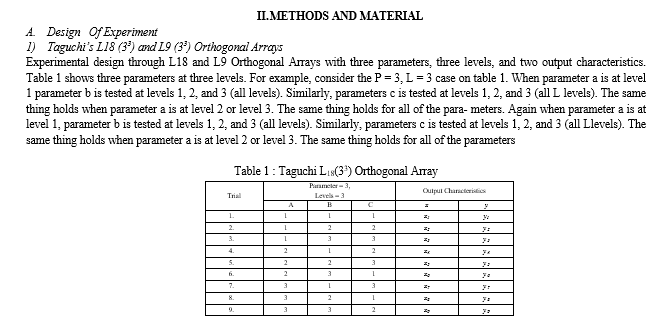
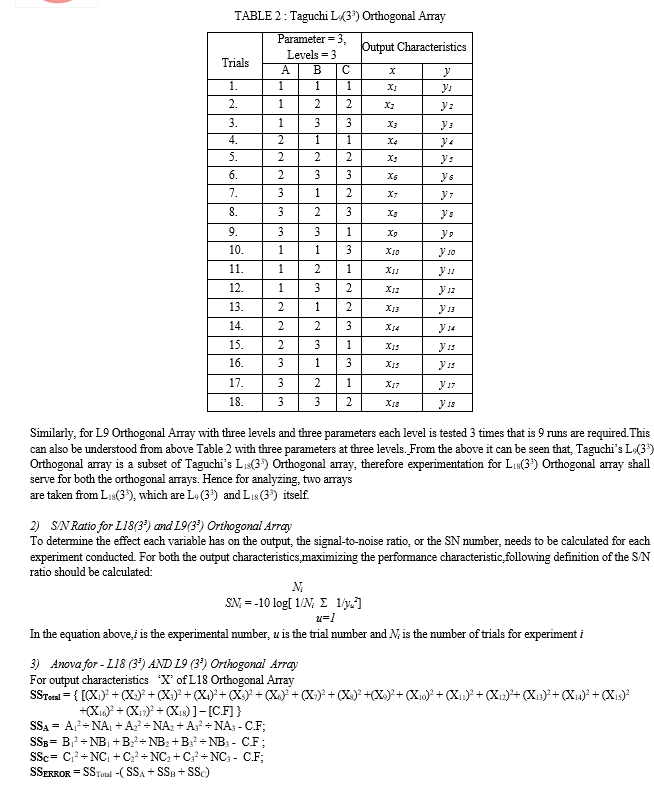
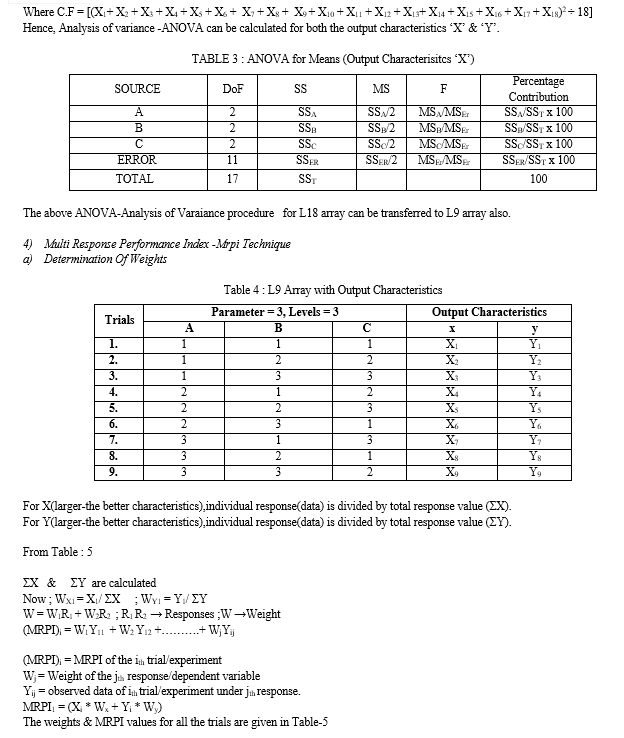
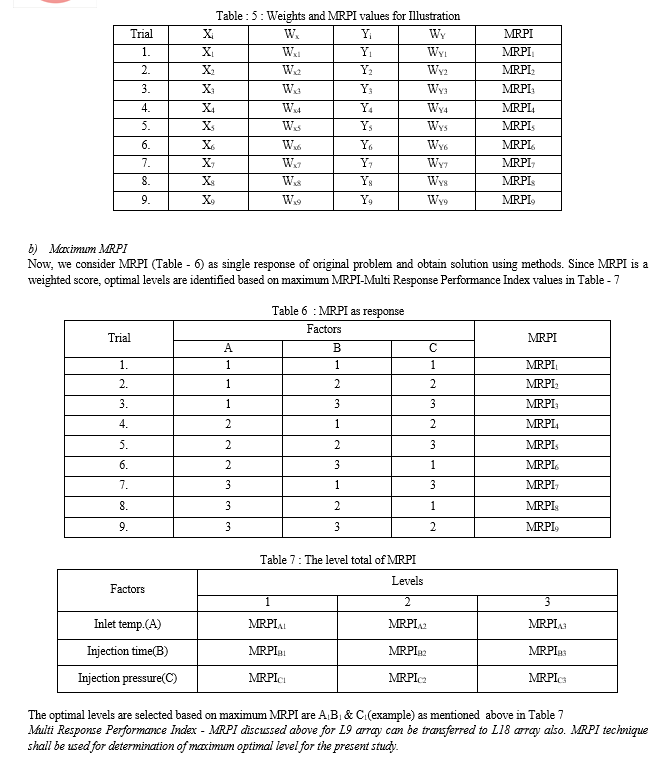


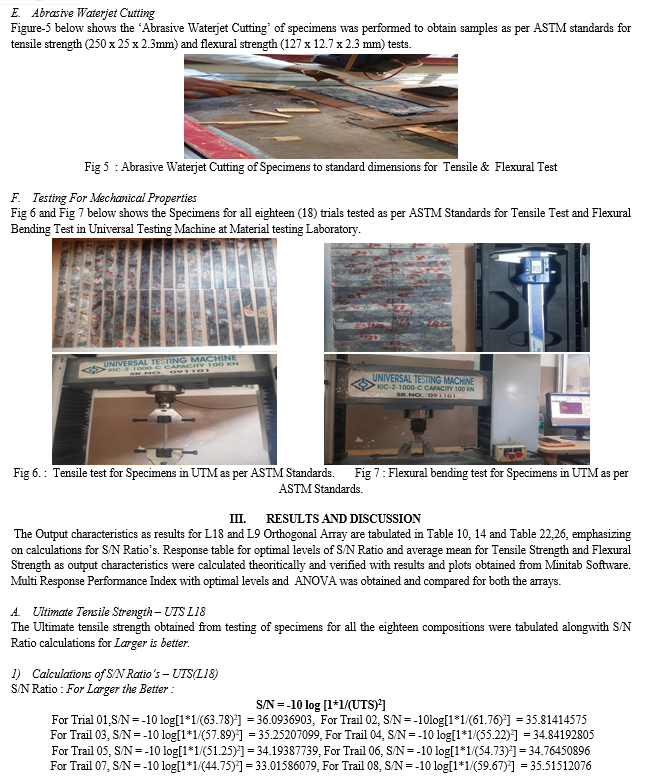
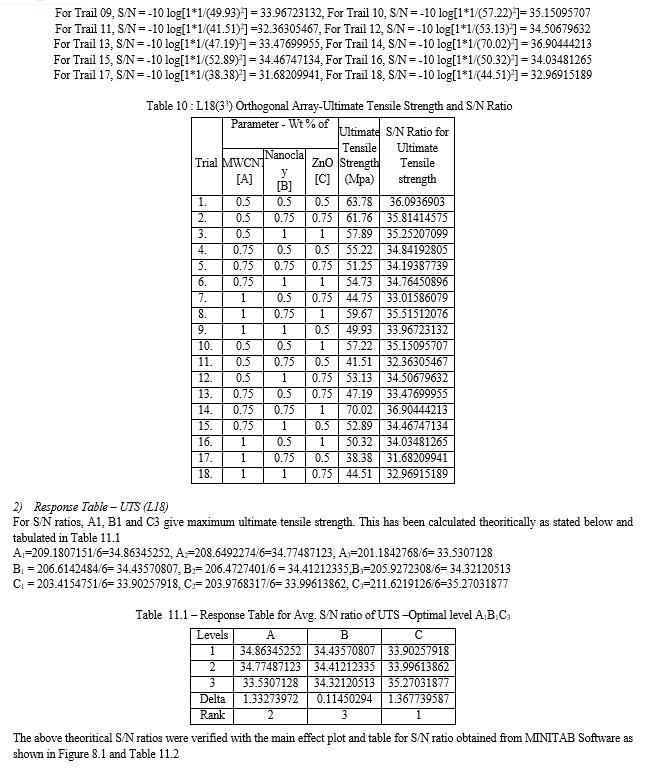

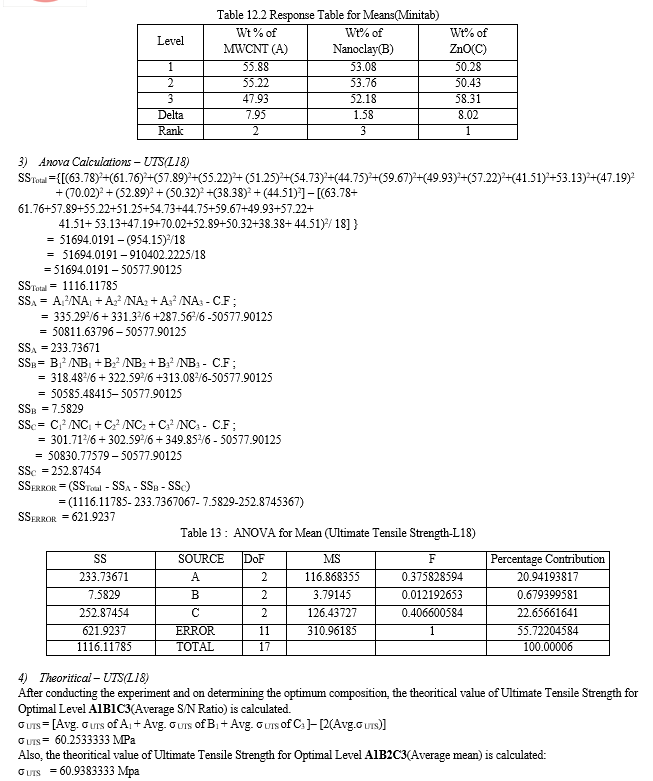
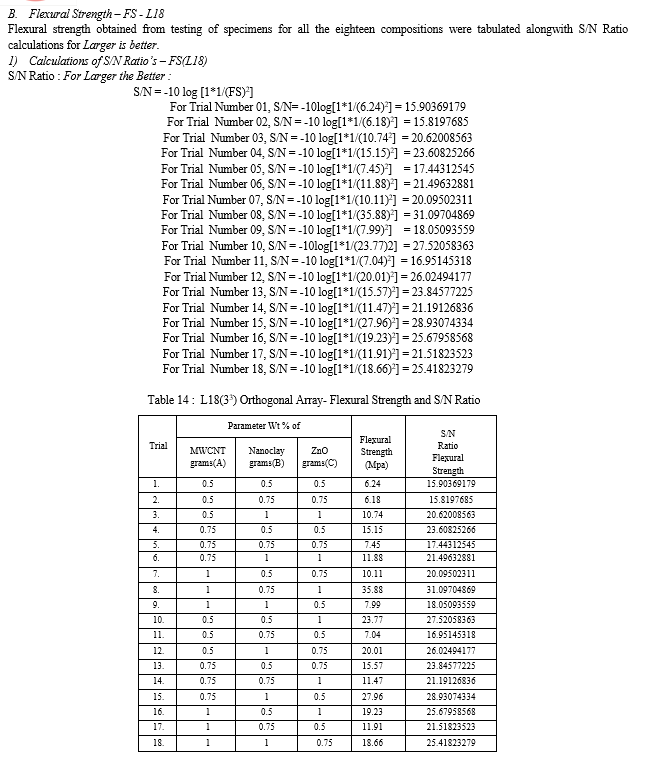
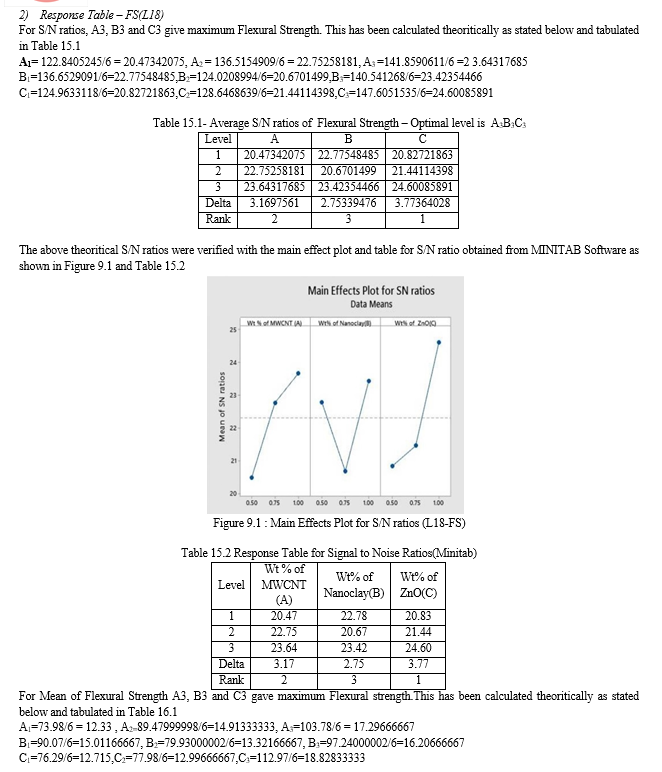

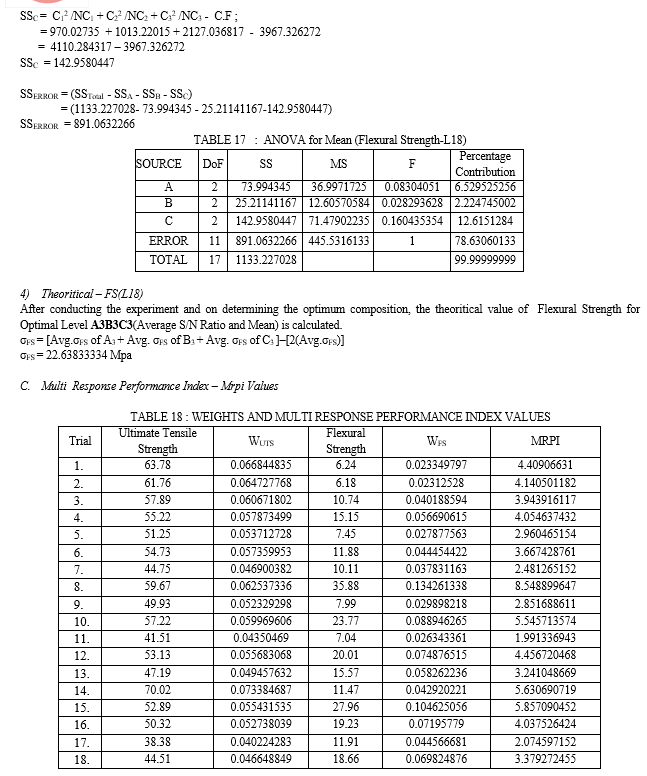

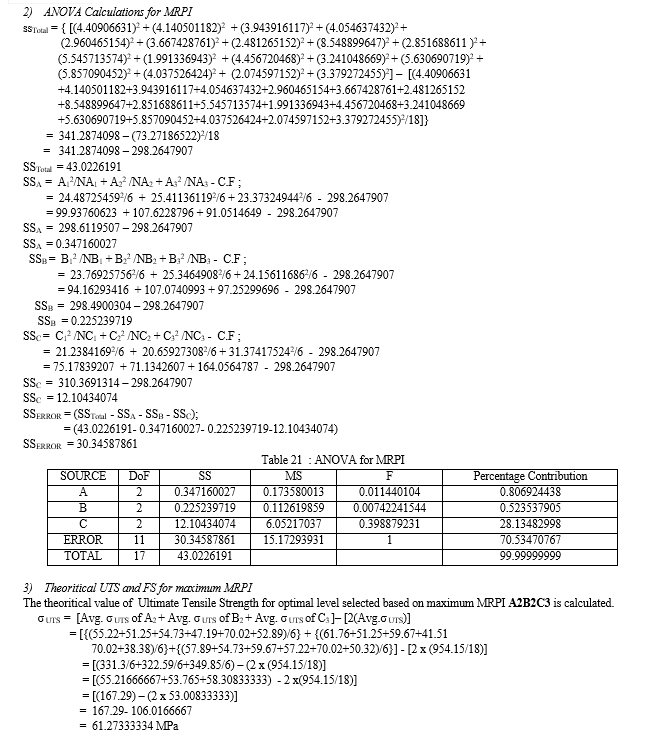


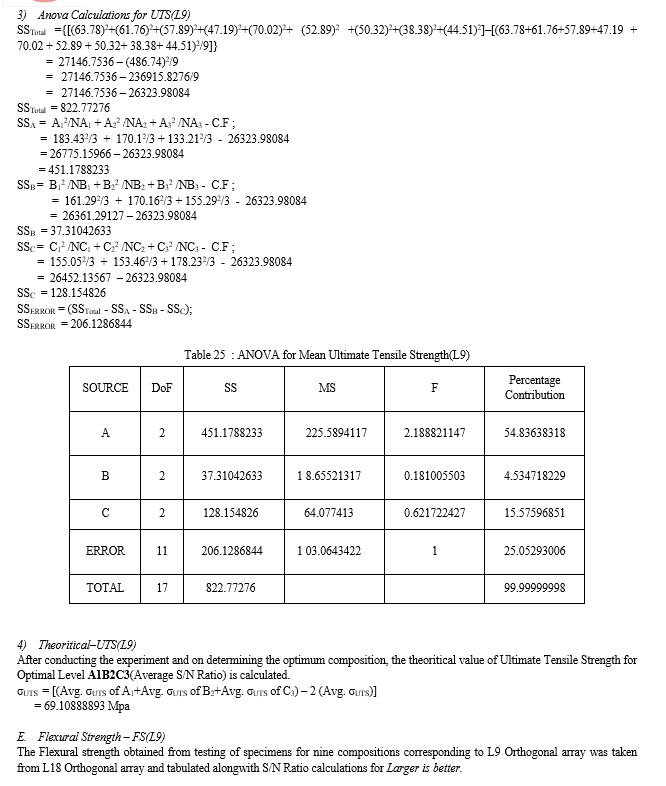
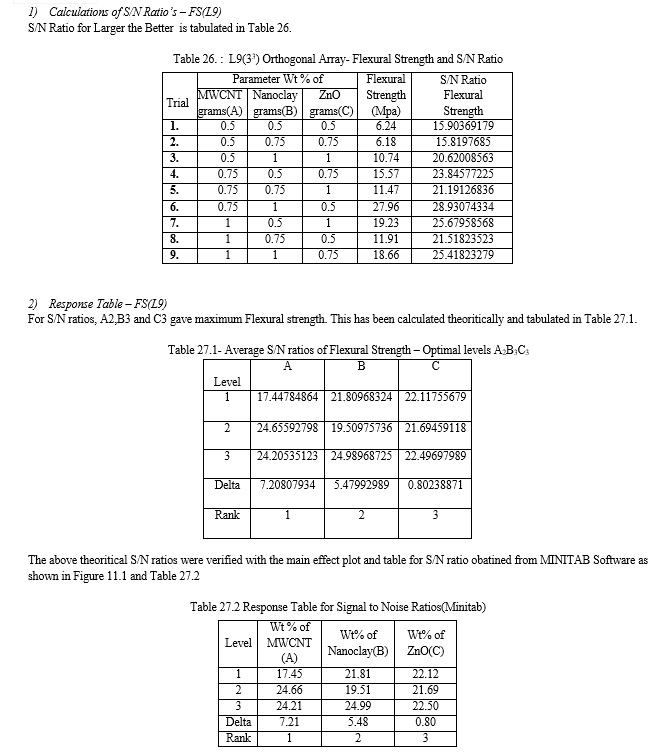

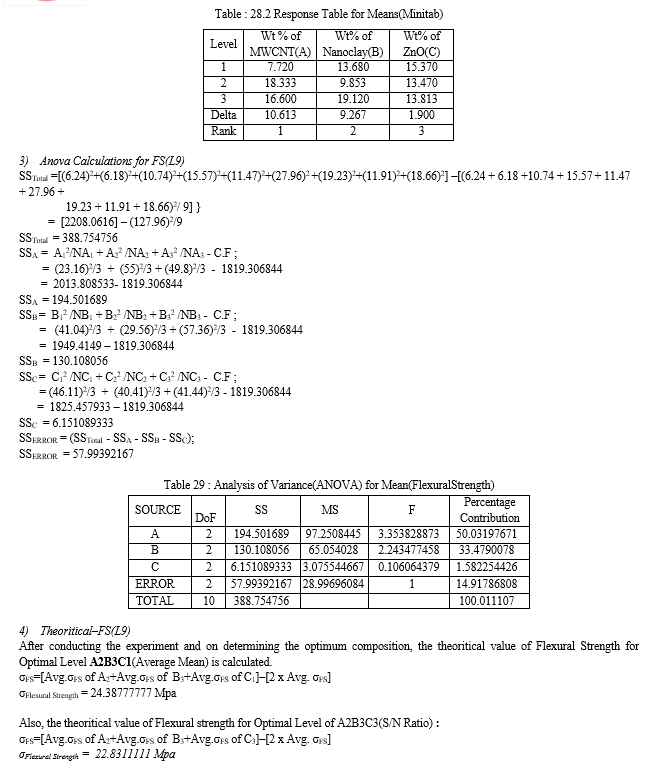
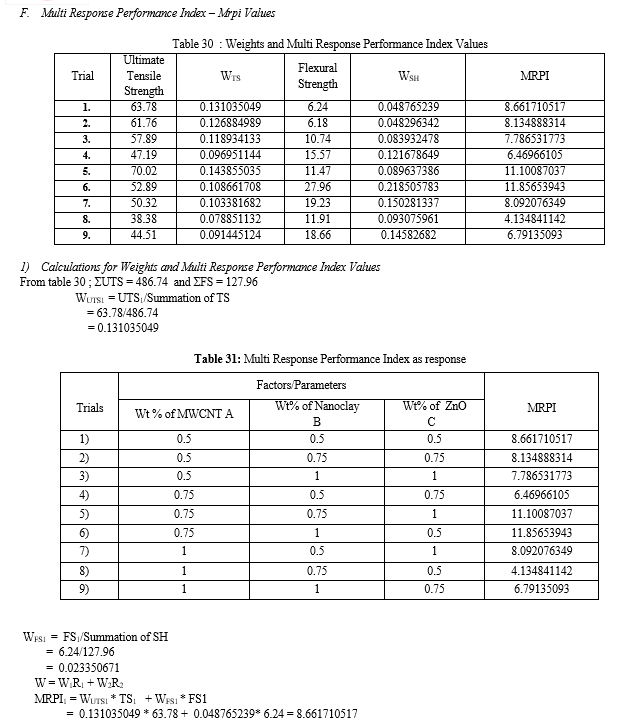
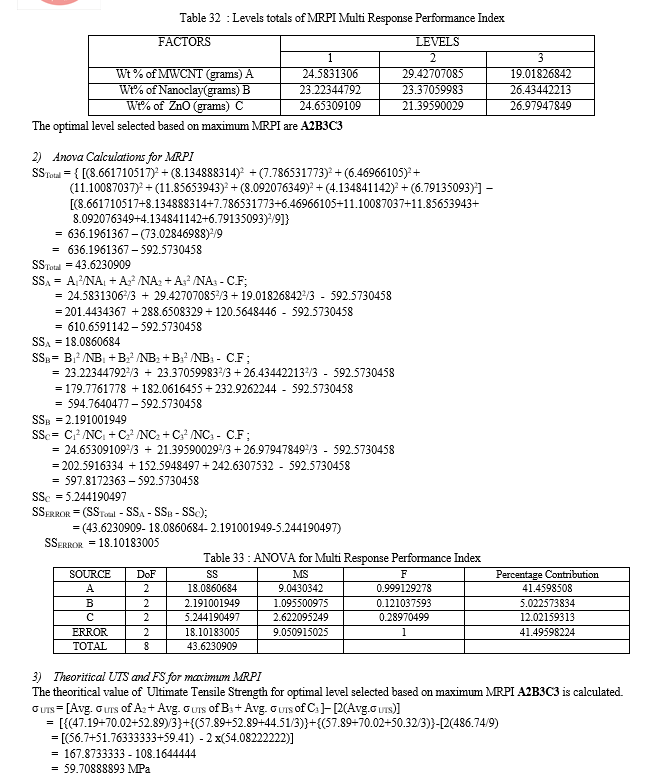

Conclusion
Addition of nanofillers with different composition of weight percentage to the Epoxy Resin enhanced the Mechanical properties of the GFRP, as the inherent properties and chemical compositions of the Multi walled carbon nanotubes, Nanoclay and Zinc oxide nanofillers were imparted to the GFRP on infusing with the epoxy resin. Based on the results of present research and investigation, conclusion has been arrived which are discussed below. 1) The Maximum Multi Response Performance Index – MRPI, for L9 array at optimal levels A2B3C3 collectively enhanced Tensile strength to 54.73 Mpa and Flexural strength to 11.88 Mpa for weight percentage of MWCNTs[A], Nanoclay[B] and ZnO[C] at 0.75%, 1 %, 1% respectively. MRPI for L18 array at optimal levels A2B2C3 enhanced tensile strength to 70.02 Mpa and the Flexural strength was reported equivalent at 11.47 Mpa for weight percentage of MWCNTs[A], Nanoclay[B] and ZnO[C] at 0.75%, 0.75 %, 1% respectively 2) Tensile Strength : It was concluded that an increase in composition of both MWCNTs and Nanoclay upto a weight percentage from 0.5 % to 0.75% keeping the weight percentage of ZnO as constant at 1%, enhanced the tensile strength of GFRP from 57.22 Mpa at A1B1C3 to 70.02 MPa at A2B2C3. 3) Flexural Strength: It was further concluded that an increase in the weight percentage of, MWCNTs from 0.75 % to 1%, ZnO from minimum 0.5% to maximum 1% and decreasing the weight percentage of Nanoclay from 1% to 0.75% enhanced flexural Strength from 27.56 Mpa at A2B3C1 to 35.88 Mpa at A3B2C3. 4) Infusing three Nanofillers - MWCNTs, Nanoclay and ZnO to GFRP Composite enhanced both tensile and flexural properties. 5) It was also investigated from ANOVA analysis that Taguchi’s L9 (33) Orthogonal array gives less error in comparison to the L18(33) Orthogonal Array both individually and collectively for MRPI. 6) ANOVA Analysis indicated Multi walled Carbon Nanotube-MWCNT has a signifcance of 54.84 % on enhancing Ultimate Tensile Strength followed by ZnOwith 15.58%. Similarly, MWCNTs had a significance of 50.03% on enhancing Flexural Strength followed by Nanoclay with 33.48 %. 7) ANOVA Analysis for MRPI-L9 indicated MWCNT has a signifcance of 41.46 % on enhancing both Ultimate Tensile Strength and Flexural Strength followed by ZnO and Nanoclay with 12.1% and 5% respectively. Similarly, ANOVA for MRPI-L18 indicated ZnO has a significance of 28.13% on enhancing both Ultimate Tensile Strength and Flexural Strength followed by MWCNTs and Nanoclay very little significance. 8) Results obtianed can be fetched to machine learning and artificial intelligence and just by performing experiments through L9 Orthogonal Array,the predictions and results can be obtained for L18 Orthogonal Array and vice versa. 9) Single Maximum optimal levels and ANOVA analysis for multiple output characteristics were significantly calculated through MRPI. 10) Experimental results and investigation forecasted future R & D work on this hybrid GFRP composite and recommends the use of Sonication and magnetic stirring for superior infusing of MWCNTs, Nanoclay and ZnO with matrix material to prevent any agglomeration. 11) Fire testings: Limit oxygen test, flame retardent test and Mechanical tests: compression test, wear test and impact test are recommended due to the infusing of MWCNT and Nanoclay with matrix. 12) The authors intends for extensive research in the domain to address fire accidents of aircraft and spacecrafts round the globe as people’s losses life. Hence, the GFRP infused MWCNTs,Nanoclay and Zinc Oxide Nanofillers could effectively outset several hybrid composites for structural applications in aerospace sector and space technology by imparting light weight,stealth,high ductility, compressiblity, bending, impact and thermal characteristics apart from resistance to fire by limiting oxygen and retarding flame that would lead to save human lifes who are travelling and working in civil, commercial and defence air transport. 13) Future investigation for fabrication of FRP through injection molding, resin transfer molding, compression molding, laying prepreg, and pultrusion to suit it for industrial application is viable. 14) Apart from the above, its intended for applications in various mechanical and automotive applications viz light weight cars structures and frames, door panel, dash board etc. 15) After thorough research work in future it is also intended for applications alongwith hybrid layer with other synthetic and natural fibres for developing stealth Drones and aircrafts for defence so as to escape enemy countries radar tracing and monitoring range.
References
[1] Shanti Kiran Zhade, Syam Kumar Chokka, V. Suresh Babu and K.V. Sai Srinadh(2021),A Review on Mechanical Properties of Epoxy-GlassComposites Reinforced with Nanoclay.https://www. intechopen. com/chapters/80631 [2] D Vinay Kumar, B M Rajaprakash , A Dissertation Phase II Work“Studies on the Impact of Nanofillers on the Mechanical Properties of Fibre Reinforced Polymers”, M.Tech in Machine Design, Bangalore University. [3] D. Vinay Kumar, B M Rajaprakash, Bupesh Kumar K, Experimental Design and Analysis of MWCNT, Nanoclay and ZnO Nanofillers on Bi-Directional-Chopped Stranded Glass Fibre Reinforced Epoxy Matrix on Mechanical Properties using L9 and L18 Taguchi’s Orthogonal Technique, doi :https://doi.org/10.32628/IJSRST24113125 [4] Abdullah Sayam, A. N. M. Masudur Rahman, Md. Sakibur Rahman, Shamima Akter Smriti, Faisal Ahmed, Md. Fogla Rabbi, Mohammad Hossain, Md. Omar Faruque(2022), A review on carbon fiber?reinforced hierarchical composites:mechanical performance, manufacturing process, structural applications and allied challenges https://doi.org/10.1007/s42823-022-00358-2 [5] Tanjheel Hasan Mahdi (2014), Characterization of MWCNT/Nanoclay Binary Nanoparticles modified composites and Fatigue performance evaluation of Nanoclay Modified fiber reinforced composites. https://apps.dtic.mil/sti/tr/pdf/ADA617906.pdf [6] Ku Zarina Ku Ahmad, Sahrim Ahmad, Mouad Ahmad Tarawneh(2012),Evaluation of Mechanical Properties of Epoxy/Nanoclay/ Multi-Walled CarbonNanotube Nanocomposites using Taguchi Method. https://www.researchgate.net/publication/ 257712486 [7] Rajhi, A.A. Mechanical Characterization of Hybrid Nano-Filled Glass/Epoxy Compsites.Polymers 2022, 14, 4852.https://doi.org/ 10.3390/polym14224852 [8] Mohammad Imanparast, Hamed Khosravi(2021) Enhancement of E-glass fiber/epoxy composite bending performance via graphene addition. M. Imanparastet et al./Journal of Particle Science and Technology 6 (2020) 61-65 [9] Susilendra Mutalikdesai, Akshay Hadapad, Sachin Patole, Gururaj Hatti(2018) Fabrication and Mechanical Characterization of Glass fibre reinforced Epoxy Hybrid Composites using Fly ash/ Nanoclay/ Zinc oxide as filler. IOP Conf. Series: Materials Science and Engineering 376 (2018) 012061 doi:10.1088/1757-899X/376/1/012 061 [10] S. Vamshi Krishna M. Pradeep Kumar A. Sridhar Properties Evaluation of Chopped, Bi-Directional and Uni-Directional Glass Fibre Reinforced Epoxy based Composites (2016)http:// www.ijirst. org/articles/IJIRSTV3I1158.pdf [11] Kamal Singh Bisht(2022),The Experimental Investigation of Mechanical and Tribological Behavior of Glass Fiber Based Epoxy Hybrid Composite Materials https://ijirt.org/master/ publishedpaper/ IJIRT154773_PAPER.pdf [12] Lokesh Vaddar,* Basava Thatti, Bijjam Ramgopal Reddy, Suneetha Chittineni, Nandipati Govind,Miditana Vijay, Chandrashekar Anjinappa, Abdul Razak,* and ChanduVeetil Ahamed Saleel(2023), Glass Fiber-Epoxy Composites with Carbon Nanotube Fillers for Enhancing Properties in Structure Modeling and Analysis Using Artificial Intelligence Technique https://doi.org/10.1021/acsomega.3c01067 [13] Tuan Anh Nguyen(2021), Study on the Synergies of Nanoclay and MWCNTs to the Flame Retardant and Mechanical Properties of Epoxy Nanocomposites https://doi.org/ 10.1155/20 21/ 5536676 [14] Rohit Pratyush Behera, Prashant Rawat , K.K. Singh , Sung Kyu Ha , Anand Gaurav , Santosh K. Tiwari(2019), Fracture analysis and mechanical properties of three phased glass/epoxy laminates reinforced with multiwalled carbon nanotubes https://doi.org/ 10.1016/ j.jsamd.2019.03.003 [15] Margarita Volkova, Raitis Sondors, Elmars Spalva, Lasma Bugovecka, Artis Kons, Raimonds Meija and Jana Andzane(2023), Epoxy-Encapsulated ZnO–MWCNT Hybrid Nanocomposites with Enhanced Thermoelectric Performance for Low-Grade Heat-to-Power Conversion https://doi.org/ 10. 3390/ polym15234540 [16] K.Devendra1,T. Rangaswamy(2013), Strength Characterization of E-glass Fiber Reinforced Epoxy Composites with Filler Materials https://dx.doi.org/10.4236/jmmce. 2013 .16054\\ [17] Maduthuri Venkatesh , V.V.S. Prasad , Ramji Koona , R. Aditya(2023),The mechanical properties and thermal behaviour of anepoxy polymer nanocomposite reinforced withmultiwalled carbon nanotubes/nano bagasse and E-glassfibre for stealth material https://doi.org/10.1016/j.matpr.2023.04.334 [18] Masoumeh Nazem Salimi, Mehdi Torabi Merajin,and Mohammad Kazem Besharati Givi Enhanced mechanical properties of multifunctional multiscale glass/carbon/epoxy composite reinforced with carbon nanotubes and simultaneous carbon nanotubes/nanoclays https://doi.org/10.1177/0021998316655201 [19] Abhishek Singh and S. C. Jayswal(2021), Mechanical Characterization of TiO2 nanoparticles based on Glass Fiber Reinforced Polymer Composite doi:10.1088/1757-899X/1206/1/01 2006 [20] Krishna G, Shivaji S(2018), Fabrication & Testing of Natural Fibre Reinforced Composite (Sun hemp & E-Glass) https://ijcrt.org/papers/IJCRT1807278.pdf [21] Rahul K,Kishor Kumar,Ch. Karunakar(2018), Flexural and Tensile Properties of Kenaf and Glass Fiber Hybrid Composite https://ijcrt.org/papers/IJCRTNTSE044.pdf [22] Elayaraja.R,Dr.Saravanan.P,Gokul.M,Gowrisankar.T(2019),Experimental Investigation of E-Glass and Kenaf Fibre with Epoxy Resin https://www.irjet.net/archives/V6/i11/IRJET-V6I1155.pdf [23] Christian Narváez-Muñoz, Camilo Zamora-Ledezma, Pavel Ryzhakov,Jordi Pons-Prats,Jee- vithan Elango,Carlos Mena, Freddy Navarrete, Víctor Morales- Flórez, Rafael CanoCrespo, Luis Javier Segura(2022),Improving Glass-Fiber Epoxy Composites via interlayer tougheningwith Polyacrylonitrile/Multiwalled Carbon Nanotubes Electrospun Fibers https://upcommons. upc.edu/handle/2117/379518 [24] Design of Experiments via Taguchi Methods - Orthogonal Arrays – Engineering Libre Texts. [25] Material Science and Engineering, A textbook by William D Callister,David G.Rethwisch,ISBN 978-1-118-32457-8,Wiley Binder Version ISBN : 978-1-118 47770-0. [26] Applied Design of Experiments and Taguchi Methods, Eastern Economy Edition,K Krishnaiah and P.Shahabudeen,ISBN-978-81-203-4527-0 [27] Taguchi Orthogonal Array, John M. Cimbala,Penn State University, 2014 version…
Copyright
Copyright © 2024 D. Vinay Kumar , B M Rajaprakash, Bupesh Kumar K. This is an open access article distributed under the Creative Commons Attribution License, which permits unrestricted use, distribution, and reproduction in any medium, provided the original work is properly cited.

Download Paper
Paper Id : IJRASET63546
Publish Date : 2024-07-04
ISSN : 2321-9653
Publisher Name : IJRASET
DOI Link : Click Here
 Submit Paper Online
Submit Paper Online

